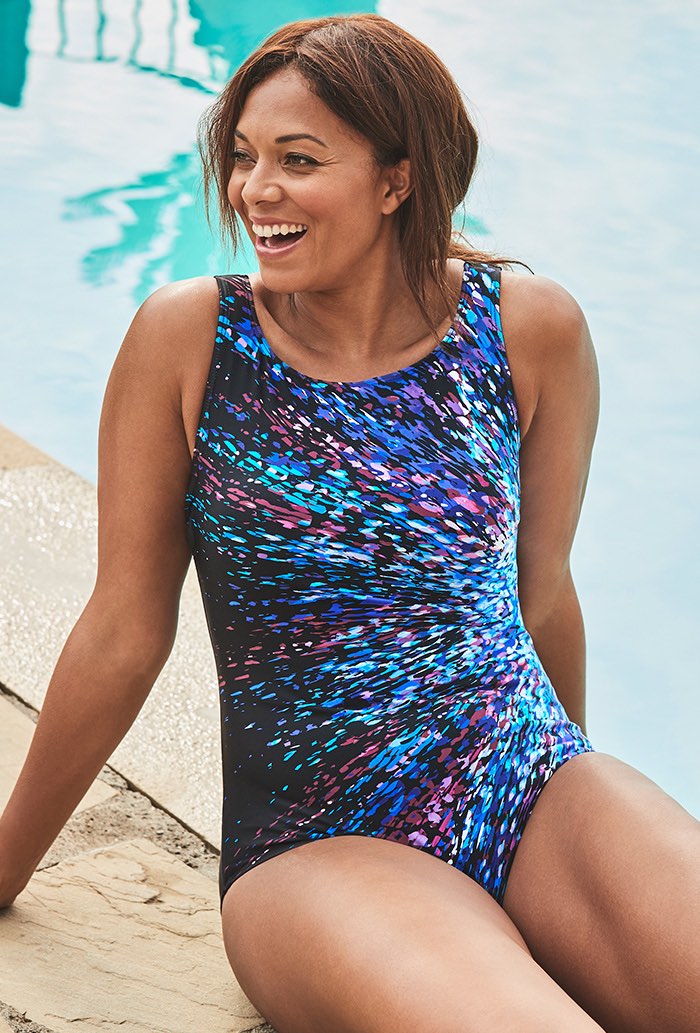Content Menu
● What Is Chlorine Resistant Swimwear?
● Why Is Chlorine a Problem for Swimwear?
● How Does Chlorine Resistant Swimwear Work?
>> Fabric Technology
● Benefits of Chlorine Resistant Swimwear
>> 1. Longer Lifespan
>> 2. Maintained Appearance
>> 3. Enhanced Comfort and Fit
>> 4. Cost-Effective
>> 5. Eco-Friendly Options
● Key Features of Chlorine Resistant Swimwear
● How to Identify Chlorine Resistant Swimwear
● Popular Styles and Options
● Care Tips for Chlorine Resistant Swimwear
● How to Choose Chlorine Resistant Swimwear
>> 1. Fabric Composition
>> 2. Fit and Comfort
>> 3. Style and Design
>> 4. Brand Reputation
>> Who Should Choose Chlorine Resistant Swimwear?
● Maintenance of Chlorine Resistant Swimwear
● Common Misconceptions About Chlorine Resistant Swimwear
>> 1. Myth: Chlorine Resistant Swimwear is Expensive
>> 2. Myth: All Swimwear is Chlorine Resistant
>> 3. Myth: Chlorine Resistant Swimwear is Uncomfortable
● Frequently Asked Questions About Chlorine Resistant Swimwear
>> 1. How long does chlorine resistant swimwear last?
>> 2. What materials are best for chlorine resistant swimwear?
>> 3. Is chlorine resistant swimwear more expensive?
>> 4. Can chlorine resistant swimwear be used in saltwater or hot tubs?
>> 5. How do I care for my chlorine resistant swimsuit?
>> 6. Can I find fashionable options in chlorine resistant swimwear?
● Conclusion
● Citations:
Swimming is a beloved activity enjoyed by millions worldwide, whether for leisure, fitness, or competition. However, frequent exposure to chlorinated pool water can wreak havoc on traditional swimwear, leading to faded colors, sagging fabric, and a shortened lifespan. Enter *chlorine resistant swimwear*—a game-changing innovation designed to withstand the harsh effects of chlorine, providing durability, comfort, and vibrant style for swimmers of all levels. But what is chlorine resistant swimwear, and why should you consider it for your next swim?

What Is Chlorine Resistant Swimwear?
Chlorine resistant swimwear refers to swimsuits specifically engineered to resist the damaging effects of chlorine and other pool chemicals. Unlike standard swimwear, which often deteriorates quickly with regular pool use, chlorine resistant swimwear is crafted from specialized fabrics—most commonly polyester or blends with PBT (polybutylene terephthalate)—that maintain their shape, color, and elasticity even after extended exposure to chlorinated water[1][2][3][4][5].
> “Chlorine resistant swimwear is specifically engineered to resist chlorine damage, which means it lasts a lot longer—and looks good while doing it!”[1]
Why Is Chlorine a Problem for Swimwear?
Chlorine is essential for keeping swimming pools clean and safe, but it is also a powerful chemical that can break down the fibers in traditional swimwear fabrics. The main issues caused by chlorine exposure include:
- Color Fading: Chlorine breaks down dyes, causing swimwear to lose its vibrant colors.
- Loss of Elasticity: Elastic fibers such as spandex or lycra degrade, leading to sagging and poor fit.
- Fabric Degradation: The overall structure of the fabric weakens, making it more prone to tears and thinning[6][4][7].

How Does Chlorine Resistant Swimwear Work?
Fabric Technology
The secret behind chlorine resistant swimwear lies in the fabric. Most chlorine resistant swimsuits are made from:
- 100% Polyester: Inherently more resistant to chlorine than other fibers, polyester maintains color and elasticity over time[1][3][8][9].
- Polyester/PBT Blends: PBT, a type of polyester, offers extra stretch and durability, making it ideal for competitive and frequent swimmers[3][4].
- Chlorine-Resistant Elastane: Some brands use specially formulated elastane that can better withstand chlorine exposure, though pure polyester options are generally more durable[2][6].
> “Chlorine resistant swimwear from H2O Wear is made from 100% polyester. This includes not only the outer fabric, but also the inner liner and the thread. Polyester is a really durable material that resists chlorine damage, maintaining both its elasticity and its color over time.”[1]
Benefits of Chlorine Resistant Swimwear
1. Longer Lifespan
Chlorine resistant swimwear can last up to six times longer than regular swimsuits, with some lasting over 600 hours in the water[10][7]. Regular swimwear may only last a few months with frequent use, while chlorine resistant options can provide a full year or more of reliable wear[1][10][11].
2. Maintained Appearance
These swimsuits retain their vibrant colors and original fit, resisting the fading and stretching that plagues standard swimwear[2][6][12].
3. Enhanced Comfort and Fit
Chlorine resistant materials provide a consistent fit over time, as they are less likely to lose their elasticity. This ensures comfort and confidence, especially for active swimmers[2][13][6].
4. Cost-Effective
Though initially more expensive, chlorine resistant swimwear is cost-effective in the long run since it requires less frequent replacement[10][12].
5. Eco-Friendly Options
Many manufacturers now offer chlorine resistant swimwear made from recycled polyester, combining durability with sustainability[3][6].

Key Features of Chlorine Resistant Swimwear
| Feature | Chlorine Resistant Swimwear | Regular Swimwear |
| Main Fabric | Polyester/PBT | Nylon/Spandex |
| Chlorine Resistance | High | Low |
| Color Retention | Excellent | Poor |
| Elasticity Retention | Excellent | Poor |
| Lifespan | 6x longer | 1-3 months (frequent use) |
| Cost Over Time | Lower | Higher (due to replacement) |
How to Identify Chlorine Resistant Swimwear
1. Check the Label: Look for terms like “chlorine-resistant,” “chlorine-proof,” or “long-lasting” on the product label or description[14].
2. Material Composition: Ensure the suit is made from polyester, PBT, or a polyester/PBT blend. Avoid high spandex or lycra content, as these fibers are not chlorine proof[14][4].
3. Brand Reputation: Choose reputable brands known for their chlorine resistant lines, such as Speedo, TYR, Arena, and others[6].
4. Special Treatments: Some suits are treated for additional chlorine resistance—look for proprietary fabric technologies or certifications[14][9].
5. Read Reviews: Customer feedback can provide real-world insight into the suit's durability and performance in chlorinated water[14].
Popular Styles and Options
Chlorine resistant swimwear is available in a wide range of styles for all ages, body types, and preferences, including:
- One-piece swimsuits
- Bikinis and tankinis
- Swim shorts and trunks
- Swim dresses, skirts, and capris
- Rash guards and cover-ups[13][15][16][17]
These suits also often include practical features such as tummy control, built-in bras, adjustable straps, and UPF 50+ sun protection[13][9][16].
Care Tips for Chlorine Resistant Swimwear
To maximize the lifespan of your chlorine resistant swimwear:
- Rinse Immediately: Always rinse your suit in fresh water after swimming to remove chlorine residue[1][18].
- Gentle Washing: Use a mild detergent and wash on a gentle cycle or hand wash. Avoid harsh chemicals and fabric softeners[1][19].
- Air Dry: Never use a dryer. Lay flat to dry indoors, away from direct sunlight to prevent damage[19][20].
- Avoid Wringing: Squeeze out excess water gently instead of wringing, which can damage fibers[11].
> Video: How to Protect Your Swimwear from Chlorine and Salt Water
>
> [
Maintenance of Chlorine Resistant Swimwear
To prolong the life of your chlorine resistant swimwear, follow these maintenance tips:
1. Rinse After Use: Always rinse your swimwear with fresh water immediately after swimming to remove chlorine and other chemicals.
2. Avoid Heat: Do not wring out or twist your swimwear, as this can damage the fabric. Instead, gently press out excess water and lay it flat to dry away from direct sunlight.
3. Use Mild Detergents: When washing your swimwear, use a mild detergent specifically designed for swimwear. Avoid bleach and fabric softeners, as these can degrade the fabric.
4. Store Properly: Store your swimwear in a cool, dry place away from direct sunlight to prevent fading and damage.
Common Misconceptions About Chlorine Resistant Swimwear
1. Myth: Chlorine Resistant Swimwear is Expensive
While some chlorine resistant swimwear may have a higher upfront cost, their durability and longevity often make them a more economical choice in the long run. Investing in quality swimwear can save you money by reducing the need for frequent replacements.
2. Myth: All Swimwear is Chlorine Resistant
Not all swimwear is created equal. Regular swimwear may not withstand the effects of chlorine, leading to fading and loss of elasticity. It is essential to choose swimwear specifically labeled as chlorine resistant for optimal performance.
3. Myth: Chlorine Resistant Swimwear is Uncomfortable
Many swimmers believe that chlorine resistant swimwear is less comfortable than regular swimwear. However, advancements in fabric technology have led to the development of lightweight and breathable materials that provide excellent comfort during swimming.

Frequently Asked Questions About Chlorine Resistant Swimwear
1. How long does chlorine resistant swimwear last?
Chlorine resistant swimwear can last up to six times longer than regular swimwear, often providing over 600 hours of pool use[10][7].
2. What materials are best for chlorine resistant swimwear?
The best materials are 100% polyester or blends with PBT. Avoid high spandex or lycra content for maximum chlorine resistance[3][14][4].
3. Is chlorine resistant swimwear more expensive?
Initially, yes. However, the extended lifespan makes it more cost-effective in the long run, as you'll need to replace your swimwear less frequently[10][12].
4. Can chlorine resistant swimwear be used in saltwater or hot tubs?
Yes, these suits also perform well in saltwater. For hot tubs, ensure the suit is rated for high chlorine environments, as some elastics may still degrade over time[20].
5. How do I care for my chlorine resistant swimsuit?
Rinse after each use, wash gently with mild detergent, avoid wringing, and air dry flat away from direct sunlight[1][19][18][20].
6. Can I find fashionable options in chlorine resistant swimwear?
Absolutely! Today's chlorine resistant swimwear comes in a variety of styles, colors, and prints to suit every taste[1][13][15][16].
Conclusion
Chlorine resistant swimwear is a smart investment for anyone who spends time in chlorinated pools. Engineered for durability, vibrant appearance, and comfort, these swimsuits outlast and outperform traditional options, saving you money and hassle in the long run. Whether you're a competitive swimmer, a fitness enthusiast, or simply love lounging by the pool, choosing chlorine resistant swimwear ensures you'll look and feel your best, swim after swim.
Citations:
[1] https://blog.h2owear.com/6-fast-facts-about-chlorine-resistant-swimwear
[2] https://www.bondijoe.com/blogs/mens-swimwear-fabric-technology/chlorine-resistant-swimwear-for-pool-lovers?srsltid=AfmBOorzhlA-KEmYvupXNiEH0HExu1zDmYUKY7LYHl0eSpk0Ab5yJpJ0
[3] https://www.leftyproductionco.com/post/finding-the-right-fabric-choosing-materials-for-durable-and-chlorine-resistant-swimwear
[4] https://www.swimmer.com.au/chlorine-resistant-swimwear.htm?srsltid=AfmBOop30A_x0Hk2glyhuem9uZxEjKI1y9MZbA33neTRxuUoZTA--3nB
[5] https://ca.baleaf.com/blogs/all-blogs/why-you-need-chlorine-resistant-swimwear
[6] https://www.bondijoe.com/blogs/mens-swimwear-fabric-technology/chlorine-resistant-swimwear-for-pool-lovers
[7] https://www.seajewelsswimwear.com.au/post/The-Truth-About-Chlorine-Resistant-Swimwear
[8] https://aus.jolynclothing.com/blogs/news/chlorine-resistant-jolyn-swimwear
[9] https://www.h2owear.com/warranty?srsltid=AfmBOorPNWvGGa1q1VIhmgaCpkrGEM9nmCGM5NxWEK7_2y1uV8YgDqxU
[10] https://seajewelsswimwear.com.au/blogs/news/the-truth-about-chlorine-resistant-swimwear
[11] https://www.reddit.com/r/Swimming/comments/1cbetgj/chlorine_resistant_bathing_suits_are_they_worth_it/
[12] https://www.activewearmanufacturer.com/the-top-four-benefits-of-the-chlorine-resistant-swimwear/
[13] https://www.swimsuitsforall.com/sa/featured/chlorine-resistant/
[14] https://seajewelsswimwear.com.au/blogs/news/how-can-you-tell-if-a-swimsuit-really-is-chlorine-resistant
[15] https://www.beactivewear.com.au/products/chlorine-resistant-one-piece-swimsuit-tropical-citrus?srsltid=AfmBOoqAR4twaQ_xb6kMNToaBnF74GhABN4xmX9T8olF2wlk_mr9aKHZ
[16] https://calypsa.com/swimwear/chlorine-resistant-swimwear.html
[17] https://www.llbean.com/buy/chlorine-resistant-suits
[18] https://www.youtube.com/watch?v=lMb-gvElK2g
[19] https://www.youtube.com/watch?v=XjUdYZWwmDQ
[20] https://www.laraines.com/chlorine-resistant-swimwear.html
[21] https://www.swimmer.com.au/chlorine-resistant-swimwear.htm?srsltid=AfmBOoqQv-isP2s5JGfBFLAD05mBq8Gi1EkVEfVgO7qLoRv-DDN-A1Ee
[22] https://www.beactivewear.com.au/products/chlorine-resistant-swimsuit-mesh-yoke-abstract-jungle
[23] https://au.baleaf.com/blogs/all-blogs/why-you-need-chlorine-resistant-swimwear
[24] https://swimweargalore.com/en-us/collections/womens-chlorine-resistant-swimwear
[25] https://www.swimt3.co.nz/blogs/swimt3-blog/do-you-need-chlorine-resistant-swimwear
[26] https://www.zoggs.com/en_AU/news/post/beginners-learning-to-swim/Zoggs%20Chlorine%20Resistant%20Swimwear%20Explained/
[27] https://ca.baleaf.com/blogs/all-blogs/chlorine-resistant-vs-regular-swimsuits-what-s-the-difference
[28] https://swimandsweat.com/collections/aquamore-chlorine-resistant-swimwear






































